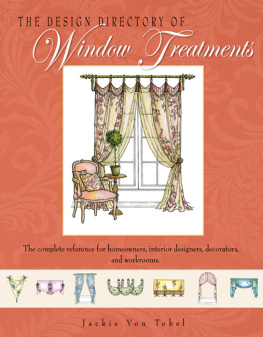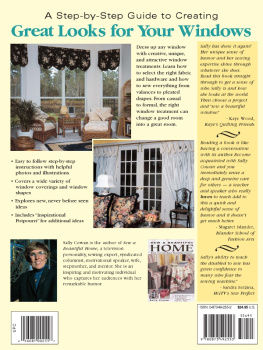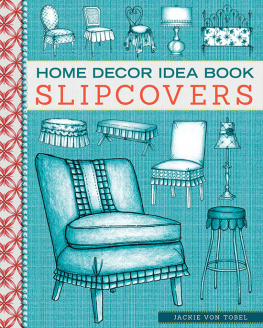Cover background fabric Vicarious Color, Desert, courtesy Robert Allen: Pattern in Color. www.robertallendesign.com; 800-333-3777; To the Trade
All rights reserved. No part of this book may be reproduced by any means whatsoever without written permission from the publisher, except brief portions quoted for purpose of review.
1. DraperiesHandbooks, manuals, etc. 2. DraperiesPictorial works. 3. Window shadesPictorial works. 4. CornicesPictorial works. 5. Valances (Windows)Pictorial works. 6. Draperies in interior decorationThemes, motivesDictionaries. 7. House furnishings industry and tradeDirectories. I. Title.
Acknowledgements
My love of fabrics and all of the beautiful things that can be made with them began at a young age. My sister Julie and I spent countless hours as small children sewing doll clothes and making dollhouses complete with little draperies and bed sets. I still feel that same passion today when a new shipment of fabric books or trims arrive. I open every new box as if it is a long- awaited birthday present and eagerly flip through the swatches, envisioning all of the wonderful possibilities they present.
A long and sometimes bumpy road has led me to writing this book and along the way there have been many important people in my life that I wish to thank.
Thanks to my always-supportive and inspiring husband, Arnie, who never questioned my ability or desire to write this book and who ate a lot of takeout dinners while I spent what seemed like thousands of hours drawing drapery.
To my beautiful daughter, Angelica, who spent so many hours copying pages and organizing binders; I couldnt have done it without you. Thanks to my boys, JT and Geordie, who were always there to lend a helping hand.
I would like to thank my wonderful sisters, Julie, Vickie, Trudi, and Valorie, for their constant support and encouragement in this and all of the other endeavors of my life.
Thanks to my inspirational drafting teacher, Al Forster, who taught me my most important lesson in design school.
I would like to impart my gratitude and admiration to the many design professionals who have shared their knowledge and expertise so openly with others, especially Deb Barrett and Joan Willis.
To Dannette, Meka, and Jacquelyn, thanks for always being there for me.
Finally, thank you to Suzanne and Madge and the wonderful staff at Gibbs Smith, Publisher, who made me feel so at home. From my first visit to your wonderful barn on salad day, I knew I had made the right choice.
Introduction
I have worked as an interior designer for almost twenty years and I still love to design window treatments.
Over the years, as many designers do, I have conducted a never-ending search for ideas and inspiration. I have attended numerous trade shows and seminars around the world, and Ive eagerly searched through every magazine I received and every book I bought for anything fresh, new, and different. This book is the culmination of that search. From basic design fundamentals to intricate multilayered designs, it contains the most complete directory of window treatments ever assembled.
The Design Directory of Window Treatments is the must have resource for designers, workroom professionals, and do-it-yourselfers. Concise, straight-to-the-point lists, definitions, and descriptions of design fundamentals and components provide a comprehensive education on window treatments.
Over 1,500 individual components and complete designs illustrated in this book are meant to provide you with the guidance and inspiration needed to encourage your creativity and enable you to stretch your design boundaries. It is an indispensable tool of the trade that no designer or workroom should be without.
Standardized definitions of industry terminology developed by the Window Coverings Association of America (WCAA) will help you communicate effectively within the industry.
Black-and-white line drawings of every color illustration in this book are available on the enclosed CD-Rom. They can be downloaded to your com- puter or you can print them and personalize them with color for your project. Also included on the CD-Rom are printable resource directories, workroom worksheets, and service request forms.
While I have made every effort to include all the pertinent information and current design options I could find, I am sure I have forgotten a few things. If you would like to post pictures of your original designs, if you have comments or suggestions for information you think should have been included, or if you would like to submit a picture or sketch of a unique design or a new idea for future revised editions of this book, please e-mail me at: ideas@designdirectory4u.com
Window Treatments
are made up of various pieces and parts that, when combined properly, produce a beautiful window dressing.
How to Use This Book
Creating a beautiful window treatment that meets the specifications of your project is all about making the right choices.
Too many times the wrong decisions are made due to lack of knowledge or exposure to the many options that are available to you. This directory breaks down thousands of current window treatment designs into over 350 individual components that can be used alone or in combination with each other to create unique designs that will expand your options and allow you to express your creativity.
Each section of the directory will assist you in making decisions critical to your design success.
Design: Using the fundamentals and calculations outlined in the first chapter, measure your window, analyze your space, and calculate the basic proportions, lay out, and construction of your design.
Fabric: Choose the fiber, weave, pattern, hand, and color of the fabrics you will use.
Heading: Plot your heading style and variations if you are designing panels, a valance, or a shade.
Style: Choose one of the finished treatments in the book or use a combination of the individual components shown to create a new look.
*Patterns are available for many of the designs. Look for the pattern maker listed below the design description. Find their contact information in the resource directory.
Embellishments: Apply the finishing touches that will personalize your design.
Hardware: Choose the appropriate type and style of hardware or mounting technique for your treatment.
Workroom: Communicate your designs effectively and accurately to your workroom to ensure that your treatments are made properly.
Design Fundamentals













